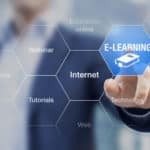
The AI Revolution in Education: A Global Call to Action
The $112 Billion Inflection Point: Architecting AI’s Role in Tomorrow’s Learning Ecosystem.
In the rapidly evolving landscape of modern education, artificial intelligence stands at a crossroads of immense promise and significant challenge. As AI tools become increasingly sophisticated and accessible, educational institutions worldwide face a critical imperative: thoughtfully integrating these technologies to enhance learning while ensuring security, privacy, and equity. This isn’t merely a technical consideration—it’s a profound shift in how we approach the fundamental mission of education in the digital age.
The time for passive observation has passed. We stand at a decisive moment that demands our active engagement in shaping how AI will transform the future of learning. If we fail to take the helm now—to guide these powerful technologies with wisdom, intention, and ethical clarity—we risk surrendering the educational experience to forces that may not prioritize the holistic development of learners or the preservation of human connection that lies at the heart of meaningful education. The question is not whether AI will change education, but whether we will direct that change toward our highest educational ideals or merely react to transformations driven by others.
The Current State of AI in Education
The educational AI market is experiencing explosive growth, projected to expand from approximately $5.18 billion in 2024 to over $112 billion by 2034 at a compound annual growth rate of 36.02%1. This remarkable growth reflects the transformative potential of AI across all levels of education, from elementary classrooms to university research labs.
However, the adoption rate varies dramatically across different regions and institutions. A recent UNESCO global survey of more than 450 schools and universities revealed that less than 10% had established institutional policies or formal guidance regarding the use of generative AI. This policy vacuum creates an environment ripe for inconsistent implementation, privacy vulnerabilities, and ethical concerns.
How AI is Currently Transforming Learning
The integration of AI in educational settings is already demonstrating promising results across multiple dimensions:
Personalized Learning Experiences
AI-powered platforms are redefining how students engage with educational content. University of Sydney’s implementation of “Smart Sparrow,” an adaptive learning platform, enables educators to create customized learning pathways that adjust in real-time to each student’s pace and performance. This personalization has increased student engagement and improved academic outcomes by tailoring education to individual strengths and weaknesses.
“The best way forward is to embrace the new technology, while implementing guardrails to prevent its abuse,” notes a study published in Sustainability2, highlighting the delicate balance required to harness AI’s benefits while mitigating potential harms.
Supporting Teachers and Administrators
Georgia Tech’s innovative “Jill Watson,” an AI teaching assistant built on IBM’s Watson platform, showcases how AI can alleviate administrative burdens. Deployed in an online Master’s program in Computer Science, Jill was trained on over 40,000 forum posts to respond to frequently asked questions, significantly reducing response times and freeing human teaching assistants to focus on more complex student needs.
Global Accessibility
At the National University of Singapore (NUS), AI systems are being leveraged to bridge educational gaps for students across diverse backgrounds. By providing personalized academic advising and support regardless of physical location or time zone, these systems are making quality education more accessible globally.
Enhanced Engagement
Brainly, an online learning platform, implemented Google Cloud’s Vision AI technology to allow students to photograph homework questions and receive instant, relevant answers. This approach has significantly increased engagement across multiple languages, making academic support more accessible worldwide.
Challenges That Must Be Addressed
The promise of AI in education comes paired with significant challenges that require immediate attention. Let’s explore some of these:
Privacy and Data Security
AI systems thrive on data, creating inherent tensions with privacy principles. As one university administrator notes, “Using AI for grading may raise issues with data privacy under laws like FERPA. Even with anonymized student data, it’s unclear where uploaded information ends up or how secure it truly is.”3
The University of Pittsburgh highlights the risk that “confidential data ingested through user interactions with free versions of GenAI chatbots may be considered a public disclosure for purposes of intellectual property rights.” The blurred boundaries between educational data and commercial interests demand robust institutional safeguards.
Equity and Access
While AI promises to democratize education, it simultaneously threatens to deepen existing divides. As a comprehensive study from Hong Kong universities noted, “AI systems, though designed with positive intent, may disadvantage some learners.”4 The study emphasizes that because AI algorithms are typically trained on historical data, they often “reflect and reproduce inherent societal biases,” potentially marginalizing already disadvantaged students.
The question of technological access compounds these concerns. As one education researcher observes, “Whilst AI is widely available, it is not universally so, and many of the most advanced versions of AI systems require a fee.”5 This creates a troubling dynamic where students from privileged backgrounds gain enhanced tools while others fall further behind. This is a moment we get to ask ourselves, is this what we want? Now is the time to make meaningful changes.
Academic Integrity Redefined
The advent of generative AI has fundamentally disrupted traditional concepts of academic integrity. A recent study titled “Use of Generative AI and Exam Results” found that students who used generative AI tools scored an average of 6.71 points lower (out of 100 possible) than those who did not. This finding suggests that AI tools may interfere with learning processes when misused.
Educational institutions must navigate this new landscape carefully, developing policies that discourage academic misconduct while recognizing AI’s legitimate role in learning.
This challenge reveals a broader imperative: comprehensive education about AI tools and their appropriate application must occur at every level of the educational ecosystem. Learning outcomes and ethical standards suffer when students, faculty, administrators, and technology developers lack a proper understanding of AI’s capabilities and limitations. Research indicates that adequate training for all stakeholders can transform AI from a potential shortcut that undermines learning into a powerful tool that enhances critical thinking and creativity.
Developing this fluency requires institutional commitment to ongoing professional development, clear ethical guidelines, and regular evaluation of how these technologies are being used in practice. Only through such deliberate efforts can we ensure that AI serves educational goals rather than subverting them.
Environmental Impact
The environmental footprint of AI technologies presents an often-overlooked ethical dimension. As the EDUCAUSE Review notes, “The cumulative environmental impact of adopting AI-powered tools for teaching, learning, and administration could be substantial.” This concern has prompted forward-thinking institutions like MIT and William & Mary to integrate discussions on the environmental costs of AI into their philosophy and data science curricula.
A Framework for Responsible AI Adoption
To navigate these complex challenges while harnessing AI’s transformative potential, educational institutions need a comprehensive framework for responsible adoption. Based on global research and implementation examples, the following pillars emerge as essential:
1. Ethical Governance and Policy Development
Educational institutions must establish clear AI governance frameworks that balance innovation with responsibility. A study from Hong Kong universities proposes an “AI Ecological Education Policy Framework” organized into three dimensions:
- Pedagogical: Focusing on how AI can enhance teaching and learning outcomes
- Governance: Addressing issues related to privacy, security, and accountability
- Operational: Managing infrastructure, training, and implementation logistics
This multi-dimensional approach ensures that AI adoption aligns with core educational values while addressing practical implementation concerns.
2. Privacy-First Implementation
Privacy considerations should be central to AI integration efforts, not an afterthought. Practical strategies include:
- Conducting rigorous Data Privacy Impact Assessments before adopting new AI tools
- Establishing clear guidelines for what student data can be collected and processed
- Implementing robust data minimization principles, collecting only what’s necessary
- Ensuring transparent communication with students and families about data usage
One educator emphasizes, “To safeguard the privacy of students and their families, school leaders, educators, and policymakers must implement a multi-faceted approach.”6
3. Equitable Access and Inclusion
To prevent AI from widening educational divides, institutions should:
- Provide universal access to AI tools regardless of socioeconomic status
- Critically evaluate AI systems for potential biases before implementation
- Design AI implementations that accommodate diverse learning needs
- Regularly audit AI systems for unintended discriminatory impacts
UNESCO’s Director-General Audrey Azoulay emphasizes that “AI offers major opportunities, provided that its deployment in schools is guided by clear ethical principles”7 and stresses that “this technology must complement the human and social dimensions of learning, rather than replace them.”
4. Teacher Empowerment
Successful AI integration depends on teachers being partners, not merely passive implementers. This requires:
- Comprehensive professional development on AI capabilities and limitations
- Involving educators in selecting and evaluating AI tools
- Providing ongoing technical and pedagogical support
- Creating collaborative communities for sharing AI implementation best practices
5. Transparent Assessment Redesign
As AI reshapes what’s possible in education, assessment methods must evolve accordingly. Forward-thinking approaches include:
- Shifting from memorization-focused tests to assessments measuring higher-order thinking
- Developing authentic assessments that evaluate skills AI cannot easily replicate
- Creating clear guidelines for appropriate AI use in different assessment contexts
- Implementing assessment approaches that value the process of learning, not just the final product
One teacher survey respondent suggested the need to “change assessment methods to measure the true ‘understanding’ of students instead of the ability to collect information (which can easily be done with AI tools).”8
Successful Implementation Examples
Around the world, educational institutions are demonstrating how thoughtful AI integration can transform learning:
The European School of Management and Business (EUDE) partnered with IBM to develop EDU, an AI-powered virtual co-tutor that handles real-time administrative, academic, and logistical queries. This implementation has shown faster student response times, increased engagement, and allowed faculty to focus on higher-value tasks.
Stanford University has established itself as a pioneer in AI education through multiple innovative initiatives. Their Stanford Accelerator for Learning and Stanford Institute for Human-Centered Artificial Intelligence (HAI) collaborate to host the annual AI+Education Summit, bringing together researchers, educators, and technologists to explore AI’s potential to transform teaching and learning. The university also created the AI Tinkery, a collaborative space for educators to experiment with generative AI in the classroom. It launched the CRAFT (Curricular Resources about AI for Teaching) project, which develops resources for teaching AI literacy in high schools.
A noteworthy Stanford study demonstrated how AI teaching assistants can enhance human tutoring. The research found that when AI assistants helped tutors rather than directly helping students, there were significant improvements in math performance, showing how AI can amplify rather than replace human teaching.
Bolton College addressed challenges in creating engaging online learning videos by implementing Synthesia’s AI-powered video creation platform. This eliminated the need for specialized equipment and technical expertise, allowing instructors to generate educational videos from simple text scripts. The result dramatically increased video-based learning resources and improved student engagement.
Loyola University Chicago developed LUie, an AI digital assistant built on Oracle’s platform that integrates with existing administrative systems. This implementation provides round-the-clock student support with personalized information drawn directly from university databases, reducing staff workload while improving student service.
cielo24, a media intelligence company, demonstrates the power of Human-in-the-Loop (HITL) technology in educational content. Their approach combines human expertise with AI automation to create highly accurate video and audio transcriptions, captions, and data labeling services for educational institutions. By blending human verification with machine processing, cielo24 ensures scalability and precision in making educational media more accessible and discoverable. This hybrid model shows how human oversight can enhance AI outcomes in critical educational applications where accuracy is paramount.
A Global Call to Action
Integrating AI in education isn’t merely a technological shift—it’s a fundamental reimagining of how we teach and learn. We must act with purpose and collaboration across global educational communities to ensure this transformation serves our highest educational ideals.
For Educational Leaders:
- Develop comprehensive AI governance frameworks that balance innovation with responsibility
- Invest in faculty development to ensure educators can leverage AI effectively and ethically
- Establish transparent AI policies that communicate to all stakeholders how AI will be used
- Create cross-institutional partnerships to share best practices and pool resources
For Educators:
- Embrace AI as a collaborative tool that enhances, rather than replaces, human teaching
- Redesign curricula and assessments to leverage AI’s strengths while developing uniquely human capacities
- Model ethical AI use for students through transparent practices
- Advocate for equitable AI access for all students, regardless of background
For Students:
- Develop AI literacy alongside critical thinking skills
- Use AI tools thoughtfully and ethically to enhance learning, not bypass it
- Provide feedback on AI implementations to help improve educational experiences
- Engage in discussions about AI ethics and implications for society
For Technology Providers:
- Prioritize privacy and security in educational AI tools
- Design with accessibility and equity as core principles
- Provide transparency in how AI systems function and what data they use
- Collaborate with educators in the development process
The Human-Machine Partnership
The most promising implementations of educational AI don’t replace human judgment but enhance it through thoughtful integration. The Human-in-the-Loop (HITL) approach exemplifies this philosophy by creating systems where AI and human expertise work together. This collaborative model maintains human oversight while leveraging AI’s analytical capabilities.
As demonstrated by cielo24’s media intelligence platform, HITL technology creates a robust synthesis of human expertise and AI automation in educational content processing. Their approach combines machine processing for scale with human validation for accuracy, ensuring that AI-powered educational media remains accessible, discoverable, and precise.
The Stanford AI Tinkery takes a similar approach by creating spaces for educators to experiment with AI while maintaining control over implementation. Rather than imposing AI tools on classrooms, this initiative empowers teachers to explore applications that enhance rather than replace their expertise.
These examples point to a future where the question isn’t whether humans or machines should lead education, but how the two can collaborate most effectively. As Stanford researcher Victor Lee notes, “It’s good to have conversations in school to talk about how AI works…not all the information’s right.”9 This approach acknowledges both AI’s potential and limitations.
Conclusion
AI in education stands at a pivotal moment that demands thoughtful implementation guided by our highest educational ideals. By addressing privacy concerns, ensuring equitable access, empowering teachers, and redesigning assessments, we can harness AI’s transformative potential while safeguarding the human connections at the heart of meaningful learning.
The path forward isn’t about whether AI will transform education—it already is. The essential question is whether we will shape this transformation deliberately, with wisdom and foresight, or allow it to unfold without considering its profound implications.
We can no longer afford to be spectators in this transformation. Each educator, administrator, policymaker, and technology developer must decide: Will we actively steer the integration of AI in education toward outcomes that elevate human potential, or will we passively allow these technologies to reshape learning without our deliberate guidance? The stakes are too high for indecision. Our students deserve educational experiences enhanced by AI’s capabilities but still anchored in human wisdom, creativity, and connection. By acting now with purpose and principle, we can ensure that AI serves our educational vision rather than defining it.
The choice is ours, and the future of education depends on how thoughtfully we make it.
References
- Acropolium. (2024). 6 AI Use Cases in Education in 2025: Benefits & Applications. ↩
- MDPI. (2023). New Era of Artificial Intelligence in Education: Towards a Sustainable Multifaceted Revolution. Sustainability, 15(16), 12451. ↩
- Synthesia. (2024). AI in Education: Use Cases, Challenges & Tools (2025). ↩
- International Journal of Educational Technology in Higher Education. (2023). A comprehensive AI policy education framework for university teaching and learning. ↩
- 9ine. (2023). AI in education: The impact of AI on privacy, data protection and ethics in education. ↩
- The Ark. (2024). AI Privacy Concerns in Schools: A Guide for School Leaders. ↩
- United Nations News. (2025). Global education must integrate AI, centred on humanity. ↩
- Inside Higher Ed. (2024). How will AI influence higher ed in 2025? ↩
- Stanford GSE. (2024). AI in the classroom: Equity, creativity, and teaching. ↩
- Axon Park. (2023). How Effective is AI in Education? 10 Case Studies and Examples.↩
- Cielo24. (2025). Unlocking the Power of Speech: How Human-in-the-Loop Transcription and Data Labeling
***




